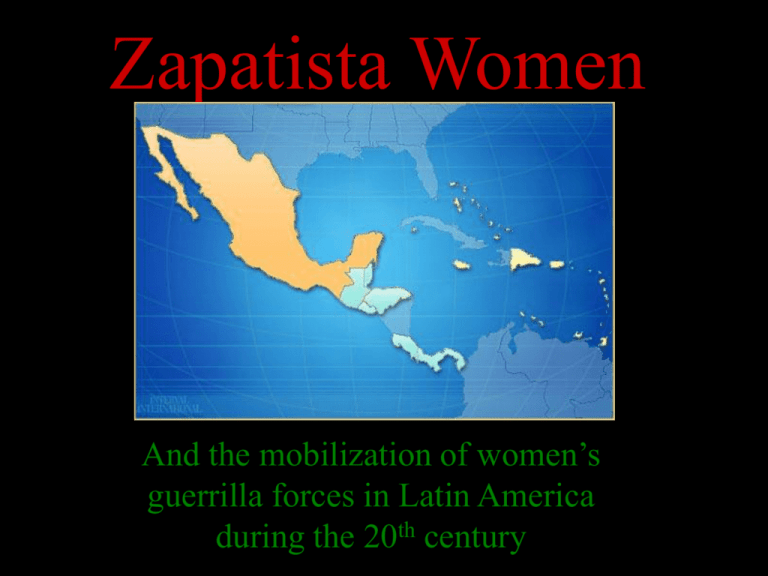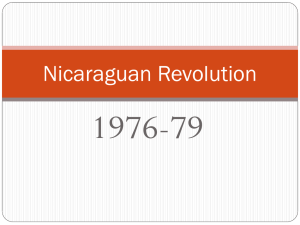Zapatista Women - Capital Social Sul
advertisement

Zapatista Women And the mobilization of women’s guerrilla forces in Latin America during the 20th century Twentieth Century Latin America The Guerrilla Hero Over the course of the century, new revolutionary movements emerged every few years across the region promoting goals of overturning dictatorships, confronting economic inequalities, and creating what Cuban revolutionary Che Guevara called the “new man.” But in fact, many of those new men were not men. Che Guevara discusses the role of women within the Cuban revolutionary forces: “Naturally the combatant women are a minority. When the internal front is being consolidated and it is desirable to remove as many combatants as possible who do not posses indispensable physical characteristics, the women can be assigned a considerable number of specific occupations…in this stage a woman can perform her habitual tasks of peacetime; it is very pleasing to a soldier subjected to the extremely hard conditions of this life to be able to look forward to a seasoned meal which tastes like something…The woman as a cook can greatly improve the diet and, furthermore, it is easier to keep her in her domestic tasks; one of the problems in guerrilla bands is that all works of a civilian character are scorned by those who perform them; they are constantly trying to get out of these tasks in order to enter into forces that are actively in combat.” Uprisings during the Cold War Era: The Nicaraguan revolution in 1979 and the rebellion in El Salvador in 1980 • Structural Changes caused by globalization led to land concentration and an increasing insecurity of the rural poor •Ideological changes caused by the rise of Liberation Theology •Organizational changes in Guerilla methods The Mobilization of Women: The reasons women join revolutionary movements are similar to men: • End dictatorship • End exploitation of the poor and indigenous • To create more just countries for their children However, it is important to understand the circumstances in Latin America’s women’s lives during the last part of the 20th century because those changes in circumstances made it possible for an increasing number of women to join guerilla organizations and other revolutionary groups. NICARAGUA The first dual-gendered guerilla movement in Latin America The FSLN overthrew Somoza dictatorship in July 1979 The Somoza Dynasty The dictatorship can be seen as a logical outcome, intended or not, of the U.S. Marines’ threat decade-long occupation of Nicaragua in the beginning of the 20th century •Anastasio Somoza Garcia – officer in the Marine-created National Guard and intellectual author of the assisination of Augusto Sandino •Sandino was the leader of a band of nationalist guerrillas who sought to end U.S. occupancy – he was ambushed and killed while leaving peace talks •Somoza seized power – four decades long of family dictatorship around violent and exclusionary policies The Sandinistas – oppositional movement of anti-imperialist and nationalist sentiments; a cross-class and dual gendered coalition Structural Changes: The effect of the globalization •Male migration and abandonment of families – agro exports more economically important, pushed people off land so men had to search for work elsewhere; men more likely to find work in agriculture than women •Increased single-female-headed households – temporary migration became permanent migration, women left economically vulnerable •Female migration that broke traditional ties and made organization possible – significant portion of migration to cities were women; led to the urbanization of Nicaragua; women joined workforce which opened up the possibility of mobilization of women through their involvement in the communities Ideological Changes The rise in Liberation Theology – the growth of religious and secular self-help groups •Vatican II Council 1962-1965: significant rethinking of Church’s role in the world to confront and influence the social problems by involving themselves in helping the suffering communities •The Latin America Bishops’ Conference at Medellin, Columbia 1968: many believe this is when the church changed sides; members of clergy worked and lived in communities of the poor – significantly deepened their commitment to change and sometimes led to political action Organizational Changes •Change in Guerrilla methods from the foco strategy to mass mobilization - the Sandinistas were the first Latin American organization to drop the small group orientation; not a non-sexist movement but rather a movement that necessitated more numbers of people •Sandinistas also changed from military to political-military strategyinnovated many different social organizations •Student groups were recruiting ground of FSLN for guerrilla movement – single most important type of revolutionary organization Political Factors State response to those self-help groups was often repression – repression pushed many women into more radical activities in self-defense The military dictators systematically tortured men but in addition to torturing women they raped them, too- often in front of their children and husbands El Salvador The FMLN declares war against the military rule in 1980, just one year after the Nicaraguan revolution. In Comparison to Nicaraguan revolution: why did the movement in El Salvador fail? •Similarities: dictatorship, rural crisis, responses because of the Liberation Theology, and U.S. role in policies •Differences: El Salvador had an impersonal dictatorship unlike the Somoza family dynasty; U.S. involvement in first half of century in Nicaragua but was involved in El Salvador after President Kennedy’s Alliance for Progress in 1960; throughout the years of fighting the center of the FMLN broke into many different and divided groups; there were far greater risks of women in El Salvador to join guerrilla forces The Rebellion in Chiapas, Mexico: A New Kind of Movement? Zapatistas arrive in Mexico City Many observers see the current EZLN movement and recent uprising in the southern state of Chiapas, Mexico, as the standard bearer for social movements all over the world. It is a war against: •the globalization of the market •against the destruction of nature and the confiscation of resources •against the growing misdistribution of wealth •and the consequent decline in standards of living for all but the rich The Zapatistas It is a movement that relies heavily on the symbols of the past – calling themselves Zapatistas in honor of Emiliano Zapata who led the southern insurrection 90 years ago during the Mexican Revolution. For Zapata and his followers it was an aggressive attempt to return the rights of land and liberty to the indigenous population According to the popular tale, on certain days the proud silhouette of Emiliano Zapata can be clearly discerned on the hilltops, and at times he can be seen galloping just above the crest of the sugar cane fields. As long as the struggle for land continues, Zapata will remain alive. Subcomandante Marcos The rebellion has been led by Marcos who has been in the public eye as the voice for the indigenous people against the oppressive Mexican government and military as well as the whole new world order The Mobilization of women to the EZLN: Structural Changes The effects of Globalization: large landowners had guardias blancas, a private police force that periodically threatened and killed Indians they considered to be trouble makers; in 1970’s many challenged power of landowners, state government violently stepped in; solution to rural crisis was to migrate to the jungle •“Colonization of the Jungle” – linguistic isolation broken out of necessity, inclusive mix of different cultures made into one indigenous cultural identity •New Jobs for men in trucking, petroleum, and tourism industries – made women more dependent because of the new importance of money rather than of subsistence; however, since the men were gone for long periods of time women had to take on new responsibilities, skills, and training = gave women confidence Liberation Theology Political Factors Fonte: http://gladstone.uore gon.edu/~cgering/Z apatista%20Women. ppt






